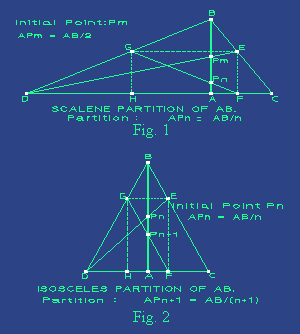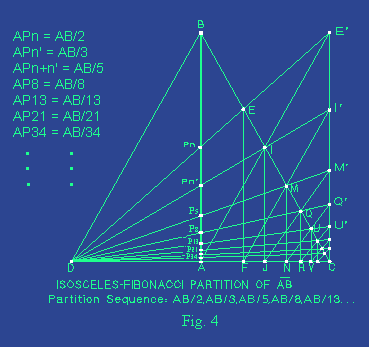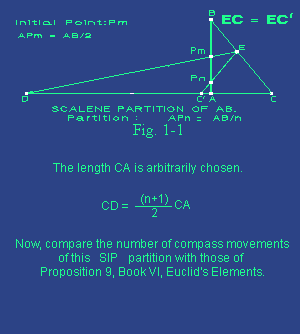|
|
Scalene
and Isosceles Partitions (SIP)
The scalene partition is a new simple construction for dividing ---by
means of compass and straightedge--- any line segment AB into n
equal parts.
- See Fig. 1
- Given any line segment AB,
trough point A draw a segment line CD
perpendicular to AB whose length is (n+1)/2
times the length CA. The length CA is
arbitrarily chosen.
- Find midpoint Pm
of AB.
- Draw BC and BD
and let the line DPm cut BC at E.
- Trough point E
draw EF parallel to AB and EG
parallel to CD.
- The line FG cuts AB
at point Pn, then :
APn = AB / n
And the line segment AB can now be divided into n equal
segments of length APn.

Given any line segment AB, Isosceles partition
is a new construction for finding ---by agency of compass and straightedge---
the following sequence of partitions (See Fig. 3).
AB/n, AB/(n+1), AB/(n+2), AB/(n+3), ...
See
Fig. 2. Given
any line segment AB draw a segment line CD perpendicular
to AB whose midpoint is located at point A and its
length is CD = 2CA. The length CA is arbitrarily chosen.
Given a starting point Pn in AB whose distance from A
is :
APn = AB / n
Draw BC
and BD and let the line DPn cut BC in E. Trough
E draw EF parallel to AB and EG
parallel to CD. The line FG cuts AB at
point Pn+1, then :
APn+1 = AB / (n+1)
The line segment AB can
now be divided into n+1 equal segments.
- (See Fig. 3)
- By continuously repeating the above steps
we will find sequentially the points Pn, Pn+1,
Pn+2 ... whose corresponding distances from A
are :
AB/n, AB/(n+1), AB/(n+2), AB/(n+3), ...

.The
Isosceles-Fibonacci Partition. Published by JTfM, Berlin,
1997.
- See Fig. 4.
- Given any line segment AB,
draw a segment line CD perpendicular to AB whose
midpoint is located at A and its length is CD=2CA.
The length CA is arbitrarily chosen.
- Given two starting points Pn and Pn' whose corresponding distances
from A are :
APn = AB / n , APn' = AB / n'
Draw the
lines BC, BD. Draw the line CE' parallel
to AB, so CE' = AB. Let the line DPn cut BC at point E and
draw EF parallel to AB. Let the line DPn' cut BC and CE'
at points I and I' respectively. The line I'F
cuts BC at point M, and the line DM cuts
AB at point Pn+n', then :
APn+n' = AB / ( n+n' )
The above expression can be
used as a second-order linear homogeneous recurrence relation. Thus, we can
repeat the above steps, this time using the starting points Pn' and Pn+n', then by continuously repeating
this procedure we can easily construct a sequence of partitions whose
denominators belongs to the well known FIBONACCI sequence.
In Fig. 4, I
deliberately chose the starting points Pn and Pn' so
their distances from A are :
APn = AB / 2 , APn' =
AB / 3
That is, n = 2, n' =
3, consequently APn+n' = AP5 = AB / 5. Of course, it is evident that one
can start with n = 1 and n' = 2.

The
Scalene Partition
(See Fig. 1) The Scalene
construction allows to find any segment of length AB/n without
constructing any other previous partitions of AB. For this reason
it is very interesting to compare this new Scalene partition with Proposition
9, Book 6 of Euclid's Elements.
In this way, in order to
find the partition AB/n of the line segment AB,
Scalene partition requires drawing seven (7) initial segments lines while
Euclid's partition requires only four (4) lines, however, in order to draw the
auxiliary segment line CD the Scalene partition requires only (n+1)/2
additional compass movements while Euclid's Proposition requires n
additional compass movements.
Considering that we are
exclusively talking about compass and straightedge, this comparison makes much
sense when n > 8, in such a case, Scalene Partition requires fewer
compass movements than Proposition 9, Book 6 of Euclid's Elements. Actually,
this compass-movements comparison should be made considering all the lines
involved in the construction. In this way, I hope the reader will be interested
in doing so for the following SIP Variation (Fig 1-1) :

Based on this, Scalene
Partition becomes more efficient than Proposition 9, Book VI of Euclid's
Elements. Actually, I must say tha in Euclid's Proposition 9 we could use only (n+1)/2
additional compass movements for constructing the auxiliary segment line, in
such a case both SIP and Euclid constructions are very similar, however, we are
asuming Euclid's proposition just as it was stated.
The Isosceles
Partition.
In Fig. 3 draw
the lines EPn+1, IPn+2, MPn+3. Now,
it is easy to prove that the lines EPn+1 and BD are
parallels. In the same way, the lines IPn+2 and ED,
the lines MPn+3 and ID, . . . and so on,
are parallels. Based on this, Isosceles partition (Fig 3) becomes
as an extremely simple method which only involves the construction of the
aforesaid parallels, that is:
EPn+1 parallel to BD , IPn+2
parallel to ED , MPn+3 parallel to ID , and so on ...
One can see that Isosceles
partition yields an unique sequence involving both the even and odd partitions
:
AB/3 , AB/4 , AB/5 ,
AB/6 , ... , AB/(n-1) , AB/n
Moreover, the most
important fact is that Isosceles Partition offers much more than the above
sequence. It is a general method which also permits ---with so much
simplicity--- the generation of many partition sequences, including FIBONACCI
(Fig 4), even-odd-denominator sequences and other higher
order sequences.
![]()
Copyright �
1993-2002
All rights reserved under international
Copyright Conventions.
No part of this page may be reproduced, stored or transmitted in any
form or by any means
without the prior
permission of the author: D. G�mez.